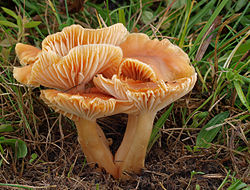Top Qs
Timeline
Chat
Perspective
Cuphophyllus
Genus of fungi From Wikipedia, the free encyclopedia
Remove ads
Cuphophyllus is a genus of agaric fungi in the family Hygrophoraceae. Cuphophyllus species belong to a group known as waxcaps in English, sometimes also waxy caps in North America or waxgills in New Zealand. In Europe, Cuphophyllus species are typical of waxcap grasslands, a declining habitat due to changing agricultural practices. As a result, six species, Cuphophyllus atlanticus (as C. canescens),[1] C. colemannianus, C. flavipes, C. lacmus, C. lepidopus, and C. radiatus, are of global conservation concern and are listed as "vulnerable" on the IUCN Red List of Threatened Species.[2]
Remove ads
Taxonomy
History
The genus was described by French mycologist Marcel Bon in 1985,[3] though it was subsequently synonymized with Hygrocybe by some authorities.[4] Cuphophyllus species have sometimes been referred to the genus Camarophyllus (Fr.) P.Kumm., but, as argued by Donk (1962), the type species of Camarophyllus must be Agaricus camarophyllus Alb. & Schwein. the species from which the genus takes its name.[5] This means that Camarophyllus sensu stricto is a synonym of Hygrophorus, since A. camarophyllus is a Hygrophorus species (Hygrophorus camarophyllus). This is now accepted by all standard authorities.[6][7][4] Singer (1951), however, proposed Agaricus pratensis (= Cuphophyllus pratensis) as the type species of Camarophyllus,[8] which means that Camarophyllus sensu Singer is a synonym of Cuphophyllus.
Current status
Recent molecular research, based on cladistic analysis of DNA sequences, indicates that Cuphophyllus is monophyletic and forms a natural group distinct from Hygrocybe sensu stricto.[9][10][11]
Remove ads
Description
Species are distinguished from most other waxcaps by producing non-viscid, typically white, grey, or brownish basidiocarps (fruit bodies) often with decurrent lamellae (gills). Species of the genus Chromosera are superficially similar, though often more brightly coloured.[4]
Habitat and distribution
In Europe, Cuphophyllus species are typically found in agriculturally unimproved, short-sward grasslands (including pastures and lawns). Elsewhere, they are most frequently found in woodland. The genus is cosmopolitan.[4]
Economic usage
Fruit bodies of one of the commoner European waxcap species, C. pratensis, are edible[4] and widely collected, sometimes being offered for sale in local markets.
Species
Summarize
Perspective
The following species are recognised in the genus Cuphophyllus:[12]
- C. acutoides (A.H. Sm. & Hesler) Lodge, Matheny & Sánchez-García (2013)
- C. adonis (Singer) Lodge & M.E. Sm. (2013)
- C. albidocinereus (Kalamees) Bon (1990)
- C. apricosus (E. Horak) J.A. Cooper (2023)
- C. atlanticus J.B. Jordal & E. Larss. (2021)
- C. aurantiopallens (E. Horak) J.A. Cooper (2023)
- C. aurantius (Murrill) Lodge, K.W. Hughes & Lickey (2013)
- C. austropratensis (A.M. Young) J.A. Cooper (2023)
- C. basidiosus (Peck) Lodge & Matheny (2013)
- C. bicolor (Dennis) Lodge & S.A. Cantrell (2013)
- C. bondii Lebeuf & I. Saar (2021)
- C. borealis (Peck) Bon ex Courtec. (1985)
- C. canescens (A.H. Sm. & Hesler) Bon (1990)
- C. canus (E. Horak) J.A. Cooper (2023)
- C. carcharias (E. Horak) J.A. Cooper (2023)
- C. cheelii (A.M. Young) J.A. Cooper (2023)
- C. cinerellus (Kühner) Bon (1985)
- C. colemannianus (A. Bloxam) Bon (1985)
- C. comosus (Bas & Arnolds) Lodge, Boertm. & E. Larss. (2020)
- C. delicatus (E. Horak) J.A. Cooper (2023)
- C. esteriae Voitk, I. Saar & E. Larss. (2020)
- C. flavipes (Britzelm.) Bon (1985)
- C. flavipesoides J.B. Jordal & E. Larss. (2021)
- C. fornicatus (Fr.) Lodge, Padamsee & Vizzini (2013)
- C. gloriae (G. Stev.) J.A. Cooper (2023)
- C. griseorufescens (E. Horak) Lodge & Padamsee (2013)
- C. impurus (E. Horak) J.A. Cooper (2023)
- C. lacmus (Schumach.) Bon (1985)
- C. lamarum Voitk, Boertm. & I. Saar (2020)
- C. laranja Desjardin & B.A. Perry (2020)
- C. lepidopus (Rea) A.M. Ainsw. (2017)
- C. neopratensis Courtec. & Fiard (2005)
- C. patinicolor (E. Horak) J.A. Cooper (2023)
- C. pegleri Lodge (1999)
- C. pratensis (Pers.) Bon (1985)
- C. pseudopallidus (Hesler & A.H. Sm.) Lodge, Boertm. & E. Larss. (2020)
- C. rainierensis (Hesler & A.H. Sm.) Lebeuf (2018)
- C. recurvatus (Peck) Lebeuf (2018)
- C. roseascens (E. Ludw. & J.G. Svenss.) Lebeuf (2018)
- C. roseipes (Massee) Lüderitz (2018)
- C. russocoriaceus (Berk. & T.K. Mill.) Bon (1985)
- C. salmonipes (G. Stev.) J.A. Cooper (2023)
- C. virgineus (Wulfen) Kovalenko (1989)
- C. yacurensis Barili, C.W. Barnes & Ordoñez (2017)
- Cuphophyllus griseorufescens
- Cuphophyllus fornicatus
Remove ads
See also
References
Wikiwand - on
Seamless Wikipedia browsing. On steroids.
Remove ads






